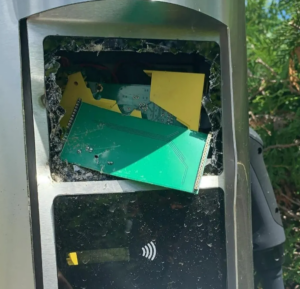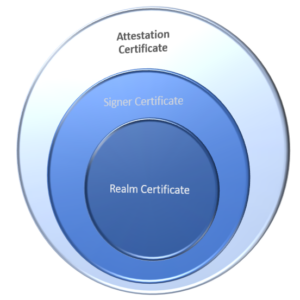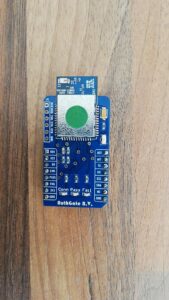An article by
Andreas Wegmann
Published on
21/11/2022
Updated on
22/12/2022
Reading time
4 min
Electric cars are on the rise in many countries and the expansion of the charging infrastructure is also being promoted by the EU. Public charging stations always emulate an self-service petrol pump, as known from fuel refuelling. With the attestation principle, it is easier, more flexible and, above all, much cheaper.
Complexity drives costs
A charging pole consists of many technical components, the number of which can be reduced with the attestation principle. Instead of building components into a charging pole, the customer’s smartphone is used. The following functions are shifted to the customer’s smartphone:
- Operation
- Communication
- Payment
The costs for purchasing and maintaining a charging station can thus be significantly reduced.
No control panel, less vandalism
 If the charging pole is controlled via the user’s mobile phone, this not only offers potential savings in hardware costs (keyword: display), but also reduces maintenance costs. Buttons or touch screen displays are not only exposed to wind and weather, but also to vandals.
If the charging pole is controlled via the user’s mobile phone, this not only offers potential savings in hardware costs (keyword: display), but also reduces maintenance costs. Buttons or touch screen displays are not only exposed to wind and weather, but also to vandals.
The necessary selection (charging duration, charging amount, green electricity, etc.) can be made on the user’s own mobile phone display and is thus a familiar process for the user.
How do you get paid? Who cares!

Of course, a charging process has to be paid for, but how this happens is irrelevant for the charging station operator. It is much more important that
- the customer is happy to use the payment method
- that the costs for the operator are as low as possible.
The procedure for payment with the attestation principle is that the customer selects his or her desired payment method during registration. The payment itself also takes place on the smartphone and not at a built-in card terminal at the charging station. The customer therefore pays on his smartphone using his payment method and only the confirmation of the successful payment is transmitted to the charging station. The comparatively low costs of a charging process speak in favour of a SEPA direct debit, as it can be processed without complex 2-factor authorisation or similar and the operator only pays a few cents in transaction costs to his bank.
Of course, card data could also be stored in the mobile app, but this is associated with ongoing high costs for the card organisations.
Communication via NFC, barcode, RFID & Co. – what’s smart?
 There are already a number of technical solutions for public charging stations that work with one or the other contactless method. The common feature of these solutions is that the charging pole itself must be connected to a background system. This is not the case when using the attestation principle: the charging pole only has a Bluetooth Low Energy (BLE) unit that is combined with a special crypto chip (attestation device). BLE is only used to communicate with the customer’s smartphone and only from there with the management system or the certificate server.
There are already a number of technical solutions for public charging stations that work with one or the other contactless method. The common feature of these solutions is that the charging pole itself must be connected to a background system. This is not the case when using the attestation principle: the charging pole only has a Bluetooth Low Energy (BLE) unit that is combined with a special crypto chip (attestation device). BLE is only used to communicate with the customer’s smartphone and only from there with the management system or the certificate server.
The user himself can operate the charging station from a distance of 1-2m. If the payment function is “in the car”, charging processes, e.g. for car sharing models, can be implemented very easily.
In contrast to conventional solutions, the crypto chip can check the individual “authorisation” of the customer and then allow the charging process. Technically, the authorisation is a nested sequence (device, user, authorisation) of encrypted certificates that cannot be manipulated. Each authorisation is unique, i.e. it is issued by the server for exactly this charging process, exactly this user and exactly this charging station.
An important advantage of BLE technology is its general availability – especially with iPhones. The use of the NFC interface would entail charges to the mobile phone manufacturer and thus be a cost disadvantage.
Data protection and fraud
With the attestation principle, no personal or sensitive data is transmitted to the charging pole, only the certificate. The charging pole also does not store any user data, so it cannot be abused by fraudsters or blackmailers. Since the charging pole itself is not connected to any background system, it does not offer any attack surface for hackers.
If the operator wants to allow completely anonymous use of the charging pole, a prepaid credit card or Bitcoin Lightning can be integrated into the system as a payment method.
Retrofittable and expandable thanks to Attestation Principle

Like all system solutions with the attestation principle, charging columns can also be retrofitted with the Attestation Device. Since the charging pole itself does not have to contain any important components, but only checks the respective authorisation, all processes are configured via the customer’s mobile app. Changes in time or charge control (weekend operation, regular customer discount, etc.) can therefore be implemented easily and quickly. Since the customer can also always be clearly (but possibly anonymously) identified in the system via his smartphone, individual user profiles can be created.
If you have any questions about our system solution, please use our contact form.
Share




